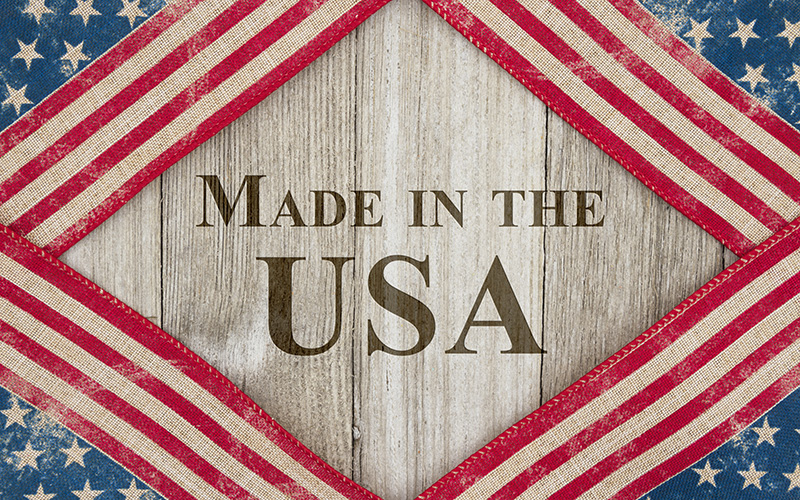Along with attention on tariffs for foreign-made goods comes a renewed focus on products that are made in the USA. According to a recent poll, whether a product is made in the USA is a factor in the purchasing decision for 61% of Americans.
The FTC declared July as “Made in the USA” month and stepped up its enforcement on unscrupulous sellers who try to take advantage of consumers’ desire for USA-made goods.
And it’s not just the FTC. The National Advertising Division of the BBB has advised several advertisers to either remove or modify their “Made in the USA” claims. States are getting in on the act with Made in the USA requirements. And attorneys are jumping in with lawsuits over false and deceptive marketing concerning products that claim to be made in the USA.
“Made in the USA” Claims
Any words or pictures–on your label or in your marketing–that state or imply that the product is made in the USA constitutes a “Made in the USA” claim. That would obviously include the actual statement”Made in the USA.” It would also include “Made in America” and “Made in Florida” (or any STATE within the United States). A picture of a US Flag is also likely to be a “Made in the USA” claim.
“Made in the USA” Requirements
In order to claim that a product is made in the USA, it has to meet the following requirements:
1. The final assembly must occur in the US.
That’s easy when you are making the product yourself, in the US.
2. All, or substantially all, of the components (ingredients) must be sourced from the USA.
That doesn’t mean bought from a US company, it means that all the ingredients were grown or made in the US. This can be a hard requirement for soap and cosmetics because so many of the oils and essential oils are from other countries, and chemical ingredients may be manufactured outside the US.
Some years back, the FTC clarified that when a product is in a tube, bottle, box, or jar, the container does not have to be sourced in the USA (it’s considered “unimportant” and the consumer ultimately throws it away).
3. Important components (ingredients) must be sourced from the USA.
Any ingredient that you particularly highlight on the label or in your marketing must be sourced from the US, even if it’s only a tiny amount in the product.
For example, if you put .4% lavender essential oil in the product and that’s the ONLY thing that isn’t from the US, then “virtually all” of the ingredients are from the US. But if you highlight that the product contains lavender essential oil then it should be from the US.
FTC Enforcement
As part of their recent enforcement activities, the FTC’s Director of the Bureau of Consumer Protection sent warning letters to 4 companies and told them to either discontinue using the Made in the USA claim or provide substantiation that their products were actually American-made.
Of particular interest, letters were also sent to WalMart and Amazon, pointing out that there are sellers in their marketplaces that are in violation of the Made in the USA rule and thus in violation of the WalMart or Amazon rules of conduct (which include being legal). The letters encourage WalMart and Amazon “to monitor, identify, and take corrective action against third-party sellers who make false or misleading “Made in USA” claims on your online marketplace.”
The fact that the FTC is putting the responsibility on the marketplace to enforce the rules for the sellers will likely have a trickle-down effect over time, with more rules, inspection and enforcement of those who sell online through WalMart and Amazon.
National Advertising Division Enforcement
The National Advertising Division of the Better Business Bureau investigates claims of false or misleading advertising and makes recommendations based on what they find.
Recent NAD cases highlight the nuances of “Made in USA” claims:
- Procter & Gamble’s Native Brand: Challenged by SC Johnson & Son (Method brand), Native had labeled its products as “Born in the USA.” The NAD determined this implied that Native products were manufactured in the U.S., and because Native couldn’t meet the “all or virtually all” standard, NAD recommended the claim be discontinued.
- Oral Essentials: GuruNanda challenged Oral Essentials’ “Made in USA” claim. Since some key ingredients were globally sourced, Oral Essentials agreed to modify its claim to “Made in USA with US and globally sourced ingredients.” This shows how claims can be qualified to better fit the Made in USA standards.
- Goose Creek Candles: Challenged by Bath & Body Works, Goose Creek had claimed its candles were “poured in USA with the highest quality of ingredients from around the world.” NAD recommended it limit the claim to only the processes or candle ingredients that actually are domestically made.
California and “Made in the USA” Lawsuits
All states have some kind of consumer protection laws, most of which prohibit false or misleading claims or deceptive marketing. Falling within that would be false or misleading origin claims, such as claiming that a product was made in the USA when it wasn’t.
California has a law which specifically prohibits the use of the phrase “Made in the USA” (or similar terms) if more than 5% of the final wholesale value comes from foreign materials (or 10% if domestic sourcing is not feasible). This is not as strict as the federal law, but it is being actively enforced in California through lawsuits.
According to The Wall Street Journal, thirteen proposed class action suits over “Made in the USA” claims have been filed so far this year, ten of which were filed by one law firm, California-based Kazerouni Law Group. Goya Foods, Procter & Gamble’s Mielle Organics, Pure Leaf Teas from PepsiCo and Unilever, and French’s Mustard maker McCormic and Co. are all feeling the heat over their “Made in the USA” claims.
Why? Money.
The law firm’s one case in 2024 resulted in a settlement whereby the company sent $5 vouchers to the class members and paid $1.35 million in costs and fees (of which Kazerouni is requesting $1.05 million and the plaintiff will get $5,000).
In April, in a case against Bigalow Tea, a jury awarded $2.36 million to class action plaintiffs… and they are requesting attorney’s fees of nearly $4.7 million.
What should you do?
If you want to make a Made in the USA claim, verify that all, or virtually all, of the ingredients are made or grown in the USA. Get documentation from your supplier and keep it on file.
If your don’t qualify for a complete “Made in the USA” claim and it’s still important to you, put a qualifier by the statement, for example, “Made in the USA with domestic and foreign ingredients.”
Remember that it’s not just the words, “Made in the USA.” It can also be similar phrases that imply made in the USA (for example, “American Made,” “Handcrafted in the US” or “Handcrafted in [my state]”) or a picture that implies made in the USA, such as an American flag in any form.
Why Does It Matter?
Making a false claim that your product is “Made in the USA” puts you at risk. It doesn’t matter if it was made accidentally or intentionally, you are still at risk.
If you sell in a marketplace, such as Amazon, WalMart or Etsy, you would be at risk of losing your right to sell on the platform due to violating the sellers’ code or agreement.
If you sell online, you have the potential of a lawsuit (if anyone thinks there’s money in it) or warnings. Worst case scenario, the FTC can impose civil fines (although that’s normally a very last resort).


Leave a Reply